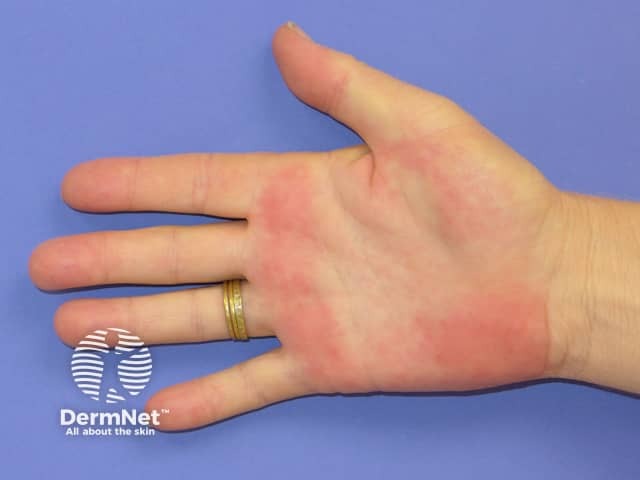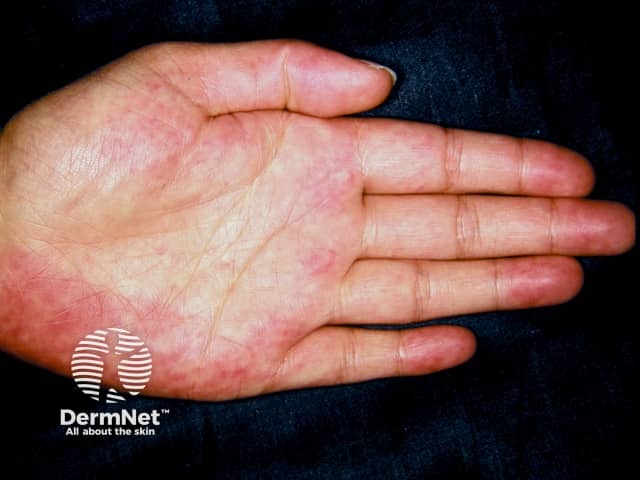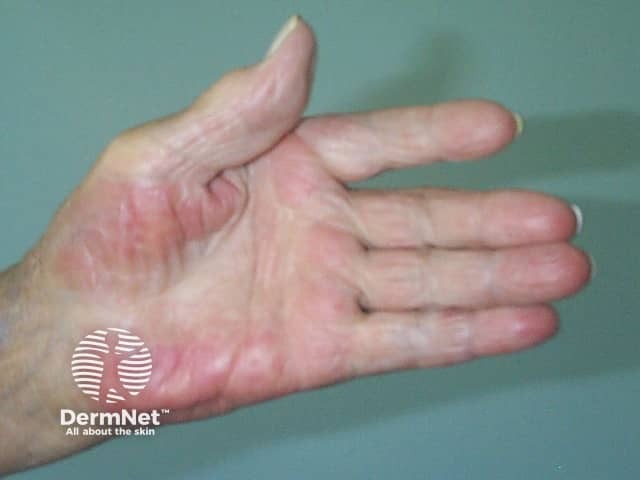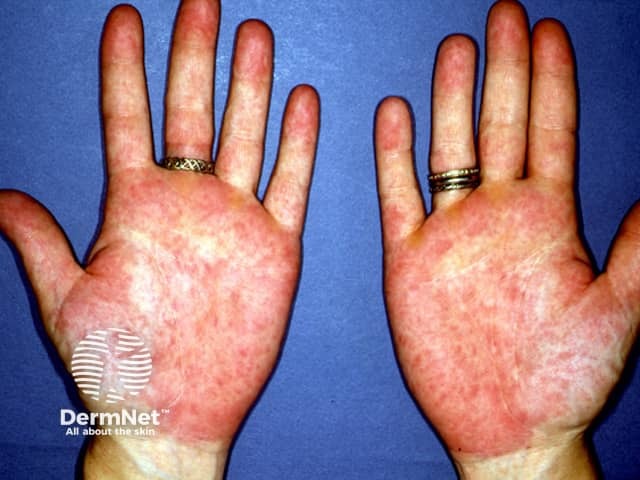Main menu
Common skin conditions

NEWS
Join DermNet PRO
Read more
Quick links
Palmar erythema — extra information
Palmar erythema
Author: George Shand, final year medical student, University of Auckland. Chief Editor: Hon A/Prof Amanda Oakley, Dermatologist, Hamilton, New Zealand, September 2015.
What is palmar erythema?
Palmar erythema is redness involving the heel of the palm, and occasionally the fingers.
What are the characteristics of palmar erythema?
The characteristics of palmar erythema include:
- Symmetrical (both hands)
- Non-painful
- Non-itchy
- Slightly warm.
The degree of redness varies with emotional states, elevation of the hand, temperature and pressure on the palm.

Palmar erythema

Palmar erythema of liver disease


What are the causes of palmar erythema?
The redness of palmar erythema is due to increased dilatation of surface capillaries in the hand. The degree of redness is often related to the severity of any underlying disease (if present). In many cases, this can be related to the amount of circulating oestrogen.
Palmar erythema may be completely normal for an individual (primary) or be a sign of underlying disease (secondary).
Primary palmar erythema
Primary palmar erythema is classified as:
- Hereditary
- Pregnancy - 30-70% of pregnant women will develop palmar erythema
- Unknown cause (idiopathic)
Secondary palmar erythema
Causes of secondary palmar erythema include:
- Liver disease: cirrhosis (23% of people with liver cirrhosis develop palmar erythema), Wilson disease, haemochromatosis
- Endocrine/nutritional: 18% of people with thyrotoxicosis and 4% of people with diabetes develop palmar erythema
- Autoimmune diseases: over 60% of people with rheumatoid arthritis develop palmar erythema
- Drug-induced palmar erythema: drugs include topiramate and salbutamol if the liver is functioning normally, or amiodarone, cholestyramine and gemfibrozil if there is liver impairment
- Other: including infections, atopic dermatitis, primary or metastatic brain cancer, smoking and chronic obstructive lung disease
In children, the most common causes of palmar erythema are:
- Hereditary palmar erythema
- Poisoning
- Kawasaki disease
- Congenital syphilis
- Wilson disease
- Hepatopulmonary hypertension.
How is the underlying cause of palmar erythema determined?
The following work-up is recommended for all patients presenting with palmar erythema:
- Complete history and physical examination
- Complete blood count
- Liver function and blood urea nitrogen/creatinine
- Hepatitis B and C virus serology
- Ferritin
- Fasting glucose
- Thyroid stimulating hormone
- Chest x-ray.
In addition to these tests, a clinician may consider ordering ceruloplasmin, proalbumin, albumin, rheumatoid factor, Cyclic Citrullinated Peptide Antibodies (CCPA), ANA, SSA, SSB, MRI brain, CT chest/abdomen/pelvis or a bone marrow biopsy.
What is the treatment of palmar erythema?
No treatment is indicated for primary palmar erythema.
If the cause of the palmar erythema is thought to be secondary to a drug, then it may be advisable to stop it. Treatment of an underlying cause of the palmar erythema may or may not lead to improvement of the redness.
References
- Serrao E, Zirwas M, English III JC. Palmar erythema. Am J Clin Dermatol. 2007;8(6):347–56. PubMed
On DermNet
- Hand-foot syndrome
- Skin signs of rheumatic disease
- Erythema palmare hereditarium
- Palmar erythema images
